The Land
from the New Zealand Handbook by Jane King,
which you can
order right now.
An Ancient Country
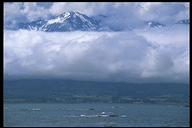 About 150 million years ago New Zealand was just a small part of the
supercontinent called Gondwanaland, consisting of present-day Australia,
Antarctica, India, Africa, and South America. About 70 million years ago, New
Zealand separated from Australia and Antarctica. Geographically isolated and
uninhabited by humans until A.D. 700 (at the earliest), New Zealand reveals its
unique natural history in its unusual animals and plants, which have long since
disappeared elsewhere.
About 150 million years ago New Zealand was just a small part of the
supercontinent called Gondwanaland, consisting of present-day Australia,
Antarctica, India, Africa, and South America. About 70 million years ago, New
Zealand separated from Australia and Antarctica. Geographically isolated and
uninhabited by humans until A.D. 700 (at the earliest), New Zealand reveals its
unique natural history in its unusual animals and plants, which have long since
disappeared elsewhere.
The Pacific and Indian-Australian tectonic plates meet along a line
of collision that runs through present-day New Zealand, producing the Taupo
Volcanic Zone in the North Island and Alpine Fault in the South Island. A
deep-sea survey has revealed that a new continent is gradually being created on
New Zealand's east coast. As the Pacific Ocean crust plunges under the eastern
North Island, thick slabs of sea sand and mud are scraped off in huge wedges
and slowly pasted to the offshore edge, forming a series of ridges along the
coast between East Cape and Kaikoura.
Volcanoes
The North Island produces enough boiling water and steam to fill all the
jacuzzis and saunas in the galaxy--or at least Los Angeles! Volcanic and
geothermal areas smolder along the Taupo Volcanic Zone from the Bay of Plenty
to the central North Island. Three volcanoes dominate this area: Mt.
Ruapehu and Mt. Ngauruhoe, both active, and dormant Mt.
Tongariro. Mt. Ruapehu erupted in September 1995, rocketing ash, steam, and
car-sized rocks into the sky from the volcano's Crater Lake. About 50 km
offshore from Whakatane in the Bay of Plenty lies White Island, an
active volcano often obscured by clouds of steam. Discovered and named by
Captain Cook in 1769, White Island erupts ash intermittently to this day.
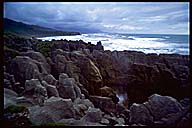 On the west coast the dormant cone of Mt. Egmont/Taranaki
towers over the Taranaki Volcanic Zone, and farther north, both
Auckland and the Bay of Islands are classified as separate volcanic
zones. The waters of Lake Taupo lie in an enormous deep crater
in the center of the North Island--the area has a violent history of
volcanic eruptions, though the last one was nearly 19 centuries
ago. You'll find no volcanos active within the last 2,000 years on the
South Island, but you can see remains of the colossal twin volcanos
that formed Banks Peninsula, south of Christchurch.
On the west coast the dormant cone of Mt. Egmont/Taranaki
towers over the Taranaki Volcanic Zone, and farther north, both
Auckland and the Bay of Islands are classified as separate volcanic
zones. The waters of Lake Taupo lie in an enormous deep crater
in the center of the North Island--the area has a violent history of
volcanic eruptions, though the last one was nearly 19 centuries
ago. You'll find no volcanos active within the last 2,000 years on the
South Island, but you can see remains of the colossal twin volcanos
that formed Banks Peninsula, south of Christchurch.
Mountains, Glaciers, and Lakes
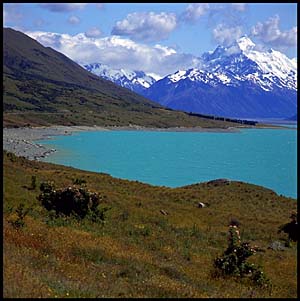
Although the North Island
offers impressive volcanos and mighty Lake Taupo, the South Island is
really the place to go for snowcapped mountain scenery and perfect
lakes set in idyllic surroundings. Most of New Zealand lies at least
200 meters above sea level, but the tallest peak, Mt. Cook
(3,744 meters), rises among the magnificent Southern Alps,
spine of the South Island. Spectacular glaciers are scattered
throughout the landscape--the mighty Fox and Franz Josef
are still easily accessible from the main route down the West
Coast. In other areas of the South Island are U-shaped valleys,
moraines, and deep lakes left behind by glaciers of earlier ice ages.
New Zealand's numerous lakes vary greatly in size and depth, many of
the largest concentrated in the South Island and fed by glaciers and
snow packs of the Southern Alps. Many fast-flowing rivers and
meandering streams follow the contours of the land. Extensive flat
plains of rich alluvial soil deposited by these rivers provide plenty
of valuable agricultural land; vast gravel plains, such as those found
in the South Canterbury region of the South Island, are predominantly
used as sheep country.
The Coastline
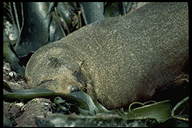 New Zealand's coastline offers a bit of everything. Sand stretches as far as
the eye can see in some areas, such as Ninety Mile Beach at the tip of
the North Island; in other areas, such as the Bay of Islands in the
northeast of the North Island and Marlborough Sounds at the South
Island's northern tip, deep coves and sheltered bays dotted with tiny islands
fringe the coast. The west coast of the South Island is lined with rocky
cliffs, blowholes, caves, and rugged surf beaches where seals haul themselves
ashore; in the far southwest corner, 14 magnificent fiords deeply indent the
coastline, and along a small section of the east coast, several sandy beaches
are strewn with large, perfectly circular boulders. For sandy beaches and warm,
aquamarine waters, stay in the north; for rugged surf-swept beaches, intriguing
rock formations, and deep, mirror-surfaced fiords, head south.
New Zealand's coastline offers a bit of everything. Sand stretches as far as
the eye can see in some areas, such as Ninety Mile Beach at the tip of
the North Island; in other areas, such as the Bay of Islands in the
northeast of the North Island and Marlborough Sounds at the South
Island's northern tip, deep coves and sheltered bays dotted with tiny islands
fringe the coast. The west coast of the South Island is lined with rocky
cliffs, blowholes, caves, and rugged surf beaches where seals haul themselves
ashore; in the far southwest corner, 14 magnificent fiords deeply indent the
coastline, and along a small section of the east coast, several sandy beaches
are strewn with large, perfectly circular boulders. For sandy beaches and warm,
aquamarine waters, stay in the north; for rugged surf-swept beaches, intriguing
rock formations, and deep, mirror-surfaced fiords, head south.
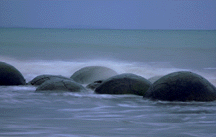
Parks
Covering more than 2.1 million hectares of the country, 13 of New Zealand's
most beautiful areas have been set aside for total preservation in their
natural state and designated national parks. They offer vast areas of untouched
wilderness where hikers, mountaineers, anglers, hunters, and flora and fauna
enthusiasts are in their element. In the North Island lie Te Urewera,
Tongariro, Egmont, and Whanganui national parks; in the South
Island, Abel Tasman, Kahurangi, Nelson Lakes, Arthur's Pass, Westland,
Paparoa, Mt. Cook, Mt. Aspiring, and Fiordland national parks. Three
maritime parks, Bay of Islands and Hauraki Gulf maritime parks in
the North Island and Marlborough Sounds Maritime Park in the South
Island, preserve some of the most spectacular and accessible coastal scenery,
and 19 forest parks, used for conservation, recreation, and timber production,
contain some of the best bush scenery in the country.
All the national parks, reserves, forest parks, and state forests
are under the jurisdiction of the Department of Conservation, created on 1
April 1987 by the Conservation Act. The department manages the land and
wildlife, promotes the conservation of natural and historic resources, produces
educational and promotional material, and fosters recreation and tourism in
conjunction with conservation. The best way to obtain information on a
particular area or park is to contact the local Department of Conservation
office.
CLIMATE
New Zealand has an oceanic, temperate climate; although it varies from
subtropical in the north to almost subarctic in the mountainous areas of the
south, overall it's relatively mild. Seasonal variations are not pronounced:
summers never get uncomfortably hot; winters are mild, with snow usually
confined to the high country and southern lowlands. Rainfall levels vary
throughout New Zealand; winter tends to be the wettest season--but not so wet
that it should be avoided. If you're coming from the Northern Hemisphere, keep
in mind that the seasons are opposite--spring is September through Novvember,
summer December through February, autumn March through May, and winter June
through August.
North Island
The North Island tends to be warmer and drier than the South Island, though the
highest mountain peaks often have snow year-round. It has an average rainfall
of 130 cm and prevailing westerly winds. Auckland (where most visitors
enter New Zealand) averages a summer temperature of 23deg. C and a winter
temperature of 14deg.. Wellington, perched on the edge of Cook Strait,
generally receives slightly colder weather with temperatures ranging from
26deg. C in summer to 2deg. C in winter. The capital also has a reputation for
windy weather, at times making the ferry trip between the two main islands
unforgettably rough.
South Island
The differences in temperature and weather in each area are more pronounced in
the South Island. The pressure systems travel west to east (the Southern Alps
have a noticeable "wet" and "dry" side), the lows dumping considerable rain and
cold temperatures on the west side of the mountains; snow is a permanent
fixture on the highest peaks. On the east side of the Southern Alps the
rainfall can be as low as 30 cm and temperatures are a good deal warmer. On the
east coast, Christchurch averages temperatures in the low 20s C in
summer and low teens in winter. Dunedin, farther south, averages 19
degrees C in summer and 10 degrees C in winter, and Invercargill, New
Zealand's southernmost city, experiences slightly colder temperatures. Snow is
relatively common in the southern lowlands as well as the higher hills, and
occasionally falls even at sea level.
Mountain Weather
As the mountains generally run north-south and the pressure systems move
west-east, the worst weather hits the highest barrier--the Southern Alps.
Rivers and streams can flood rapidly from snowmelt and rain, avalanche risks
increase dramatically, and temperatures drop quickly. Watch for an increase in
wind strength and the formation of large sheets of cloud. Also watch for clouds
gathering over the lee side of the ranges--and expect rain. Gale-force winds,
snow, or blizzards can come with these storms at any time of year in the
mountains. The New Zealand Mountain Safety Council suggests three important
rules to follow: be aware of approaching bad weather (expect it in the
mountains), be adequately prepared with warm, wind- and waterproof clothing,
and don't cross flooded rivers--wait until they subside (generally as quickly
as they flood). For detailed weather forecasts, check the newspaper or tune in
to local radio or TV stations. If you're in a national park, park HQ usually
has the latest local weather forecast.
Clothing to Suit the Climate
If you're traveling clear around the country you're sure to bump into most
types of weather--and even if you're staying in one area, the weather still
changes rapidly. The safest policy is to be equipped for everything, no matter
the season. Wear layers of clothing (shirt, sweater, and windproof jacket) to
strip off and replace as needed. Wet-weather gear, a warm windproof jacket,
wool sweater or cardigan, bathing suit, and comfortable footwear (hiking boots
if you're venturing off the beaten track) are essentials at all times of year.
(For more clothing tips, see "What to Take," under "Services and Information"
in the On the Road chapter.)
FLORA
The Bush
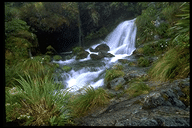 New Zealand's long isolation from other continents is responsible for some
unique developments in plant and animal life. Before humans arrived, much of
the country was covered in dense tangled forests and heavy undergrowth alive
with native birds, many flightless. With the introduction of grazing animals,
much of the undergrowth was thinned out; early settlers felled the forests, and
introduced predators chased many unique birds into extinction. Today, the
remaining native forests are lush wonderlands of subtropical appearance. Ferns,
mosses, and lichens carpet the floor, tree ferns grow up to 10 meters high, and
twining creepers, nikau palms, palm lilies, tree ferns, and many species
of native trees intermingle to form a dense green canopy overhead--called "the
bush" by New Zealanders. For fern lovers, New Zealand is a delight. Ferns (one
of the country's national emblems) seem to grow everywhere--on trees, along
rivers and streams, on hillsides, and in open areas, and the more than 150
species range in size from filmy two-cm ferns to impressive 15-meter tree
ferns.
New Zealand's long isolation from other continents is responsible for some
unique developments in plant and animal life. Before humans arrived, much of
the country was covered in dense tangled forests and heavy undergrowth alive
with native birds, many flightless. With the introduction of grazing animals,
much of the undergrowth was thinned out; early settlers felled the forests, and
introduced predators chased many unique birds into extinction. Today, the
remaining native forests are lush wonderlands of subtropical appearance. Ferns,
mosses, and lichens carpet the floor, tree ferns grow up to 10 meters high, and
twining creepers, nikau palms, palm lilies, tree ferns, and many species
of native trees intermingle to form a dense green canopy overhead--called "the
bush" by New Zealanders. For fern lovers, New Zealand is a delight. Ferns (one
of the country's national emblems) seem to grow everywhere--on trees, along
rivers and streams, on hillsides, and in open areas, and the more than 150
species range in size from filmy two-cm ferns to impressive 15-meter tree
ferns.
Trees
Altogether 112 native tree species grow in New Zealand amongst the dense
undergrowth and large areas of scrub (mainly manuka or tea-tree). A few
ancient kauri pine (Agathis australis) forests can still be appreciated
on the North Island, growing naturally only north of latitude 39 degrees south.
These magnificent trees grow up to 53 meters high, losing their lower branches
to become long bare cylinders of intricate design with large bushy tops. They
were the favorites of the forest for Maori war canoes--a vast canoe could be
chiseled out of one tree trunk. Unfortunately, they were also the favorites of
early shipbuilders and settlers, who rapidly depleted the forests without much
thought to the future--the kauri takes about 800 years to mature. Nowadays,
these impressive trees survive in relatively few areas, towering above the
other trees in small groves or randomly in the bush. Two areas in Northland,
northwest of Dargaville, are worth a special visit just to see these
giants--Waipoua Forest Park, with two very famous trees (one is
estimated to be at least 2,000 years old), and the small but beautiful
Trounson Kauri Park.
Most of New Zealand's flowers are white or cream. However,
native flowering trees and shrubs add red and yellow highlights to the
evergreen flora of New Zealand. A few of the most spectacular flowering trees
are the pohutukawa, rata, and kowhai. The striking pohutukawa
(Metrosideros tomentosa), or New Zealand Christmas tree, is a mass of
scarlet flowers in December. The rata (Metrosideros robusta), another
vividly colored tree also covered in red blossoms, is initially a parasitic
vine, growing up a host tree (often strangling it) until it has grown roots and
become a tree in its own right. The bright yellow hanging blossoms of the
kowhai (Sophora tetraphera) bloom in all their glory during spring.
Large beech (Nothofagus) forests with little undergrowth cover upland
areas, and vast areas of land throughout New Zealand have been planted with
exotic trees for timber, thus saving the remaining indigenous trees. The most
common nonnative tree is the radiata pine. It flourishes here, growing to
complete maturity within 35 years--a popular tree with the timber industry.
Flowers
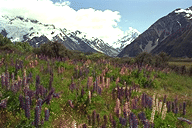 At least three-quarters of New Zealand's flowering plants are endemic. Orchids
are abundant, adding multihued splashes of color to the landscape. About 60
species thrive in the lowland forests and countless beautiful parks and
gardens. The alpine flowers are vastly different from those of other countries,
with about 500 species of flowering plants found only in New Zealand's alpine
areas. Large, white mountain daisies (Genus Celmisia) are the most
common; the beautiful Mt. Cook lily (Ranunculus lyallii) is the largest
of the buttercups. A rather strange growth called vegetable sheep (Raoulia
eximia), a large, low-to-the-ground, cushionlike plant covered in white
hairs, grows only in the South Island and is easily mistaken for a sheep from a
distance! Apart from the abundance of native wildflowers, New Zealanders also
take great pride in their gardens. If you're a flower fancier, stroll through
any of the suburbs (particularly of Hamilton, Cambridge, New Plymouth, Napier,
and Christchurch) to see a great variety of both indigenous and exotic
plantlife, tended with obvious TLC (most New Zealanders are born with green
thumbs). Botanical gardens, reserves, and beautiful parks (called "domains")
are found in most cities, and are highly recommended as part of any walking
tour.
At least three-quarters of New Zealand's flowering plants are endemic. Orchids
are abundant, adding multihued splashes of color to the landscape. About 60
species thrive in the lowland forests and countless beautiful parks and
gardens. The alpine flowers are vastly different from those of other countries,
with about 500 species of flowering plants found only in New Zealand's alpine
areas. Large, white mountain daisies (Genus Celmisia) are the most
common; the beautiful Mt. Cook lily (Ranunculus lyallii) is the largest
of the buttercups. A rather strange growth called vegetable sheep (Raoulia
eximia), a large, low-to-the-ground, cushionlike plant covered in white
hairs, grows only in the South Island and is easily mistaken for a sheep from a
distance! Apart from the abundance of native wildflowers, New Zealanders also
take great pride in their gardens. If you're a flower fancier, stroll through
any of the suburbs (particularly of Hamilton, Cambridge, New Plymouth, Napier,
and Christchurch) to see a great variety of both indigenous and exotic
plantlife, tended with obvious TLC (most New Zealanders are born with green
thumbs). Botanical gardens, reserves, and beautiful parks (called "domains")
are found in most cities, and are highly recommended as part of any walking
tour.
FAUNA
Birds
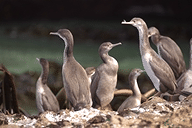 Until humans arrived these islands had no native land animals, except for two
species of bat discovered by early settlers. However, the country was alive
with birds, no fewer than 250 species. A perfect balance of nature existed
between vegetation and birdlife, but when humans set foot on the islands they
brought rats, cats, and introduced mammals and birds. Many native birds, unable
to adapt to the foreign predators, became extinct. Native birds in the forest
today include the tui (with its beautiful song), bellbird (its
crystal-clear call is like the ping-pong of a door bell), fantail, kaka,
kea, pukeko, morepork, and wood pigeon. The kaka is a shy, brown and
green parrot. The kea, a dull brownish-green parrot with red underwings
and a hooked beak, lives in the high country and is commonly seen in the
Southern Alps as it scavenges around campsites. Cheeky and daring, it can cause
a lot of damage to tents, boots, bicycle seats, or anything it can tear with
its strong beak, and it has the reputation for sliding down the iron roofs of
alpine huts in the wee hours of the morning.
Until humans arrived these islands had no native land animals, except for two
species of bat discovered by early settlers. However, the country was alive
with birds, no fewer than 250 species. A perfect balance of nature existed
between vegetation and birdlife, but when humans set foot on the islands they
brought rats, cats, and introduced mammals and birds. Many native birds, unable
to adapt to the foreign predators, became extinct. Native birds in the forest
today include the tui (with its beautiful song), bellbird (its
crystal-clear call is like the ping-pong of a door bell), fantail, kaka,
kea, pukeko, morepork, and wood pigeon. The kaka is a shy, brown and
green parrot. The kea, a dull brownish-green parrot with red underwings
and a hooked beak, lives in the high country and is commonly seen in the
Southern Alps as it scavenges around campsites. Cheeky and daring, it can cause
a lot of damage to tents, boots, bicycle seats, or anything it can tear with
its strong beak, and it has the reputation for sliding down the iron roofs of
alpine huts in the wee hours of the morning.
The takahe, a rare bird unique to New Zealand, is found
mainly in Southern Fiordland. Large, flightless, blue and green with red feet
and bill, it was thought to be extinct until a small colony was rediscovered in
1948. Since then, 120 takahes have been found and are now protected in a
restricted area in the Murchison Mountains. Probably the best-known creature of
New Zealand is the nocturnal kiwi, a flightless bird found nowhere else in the
world--the national emblem of New Zealand. It has a round body covered in
dense, stiff feathers (looks like shaggy fur from a distance), strong legs
(kicks out when frightened), no tail, tiny invisible wings, a long beak, and a
piercing call--"ki-wi." It's not easy to find a kiwi in the bush, but you can
see them in a simulated natural environment in the many excellent nocturnal
houses throughout the country.
The weka, another flightless bird, is as bold as the
kea but not as common. Found in the west coast forests of the South
Island and the Gisborne area of the North Island, it also helps itself to the
food and property of campers. Introduced birds include the blackbird, thrush,
magpie, chaffinch, sparrow, skylark, myna, white-eye, and goldfinch.
Fish, Insects, and Reptiles
Known for its excellent fishing (fly and lure), New Zealand draws angling
enthusiasts from around the world to dangle their lines in its lakes and rivers
where fish grow to a healthy size and braggable weight and put up an admirable
fight. Brown and rainbow trout, salmon, and char are the best-known freshwater
fish. Brown trout are widespread and common; rainbow are more common in North
Island lakes, but also live in many upland lakes of the South Island. Deep-sea
fishing for marlin, sharks, and tuna is a popular sport in the Bay of
Islands.
Of the numerous forms of insect life found throughout the country,
one of the most audible is the cicada. Twenty or so species of cicada live in
New Zealand, mostly above the timberline. Often mistaken for that of crickets,
their song in the summer heat is an incredibly loud, raspy, clicking noise--one
that seems to intensify in the evening--a distinct part of the summer
atmosphere in New Zealand. The tuatara, a lizardlike reptile, now
inhabits only about 30 islands off the country's coast (see live ones in the
Southland Museum Tuatarium in Invercargill). It is believed to live at least
100 years, has a distinctly prehistoric appearance, and is often referred to as
a "living fossil."
Mammals
The wild animals in New Zealand are descended from pigs, goats,
opossums, rabbits, weasels, ferrets, and deer released by European settlers.
Some of these--especially deer, rabbits, goats, and opossums--adapted to their
new environment so well that they rapidly became an environmental problem and
had to be drastically hunted to control their populations. Many domestic
animals also adapted well to New Zealand, and play a large part in the success
of the country's economy. Sheep (more than 68 million of which dot the
countryside--roughly 20 sheep for every resident), cattle, and poultry are of
prime importance.
Of eight species of deer, the red deer is the most common and
widespread. When first released it had an abundant food supply (rapidly
destroying the native forest undergrowth) and no predators, and its numbers
increased rapidly. Commercial hunting from helicopters began in the 1960s,
followed by profitable heli-hunting with live capture for deer farms. Hunting
is still encouraged, but in recent years controlled deer farming has become a
valuable part of the economy. The deer are raised for meat, breeding stock, and
for their antlers, which when in velvet are sold to the Asian market, crushed,
and used as an aphrodisiac. The largest alpine mammals are tahr and chamois,
distantly related to the goat. Excellent rock climbers, they are hunted for
trophies.
[ Back | Up to cover page | On to History ]
Add a comment | Add a link
 About 150 million years ago New Zealand was just a small part of the
supercontinent called Gondwanaland, consisting of present-day Australia,
Antarctica, India, Africa, and South America. About 70 million years ago, New
Zealand separated from Australia and Antarctica. Geographically isolated and
uninhabited by humans until A.D. 700 (at the earliest), New Zealand reveals its
unique natural history in its unusual animals and plants, which have long since
disappeared elsewhere.
About 150 million years ago New Zealand was just a small part of the
supercontinent called Gondwanaland, consisting of present-day Australia,
Antarctica, India, Africa, and South America. About 70 million years ago, New
Zealand separated from Australia and Antarctica. Geographically isolated and
uninhabited by humans until A.D. 700 (at the earliest), New Zealand reveals its
unique natural history in its unusual animals and plants, which have long since
disappeared elsewhere.





